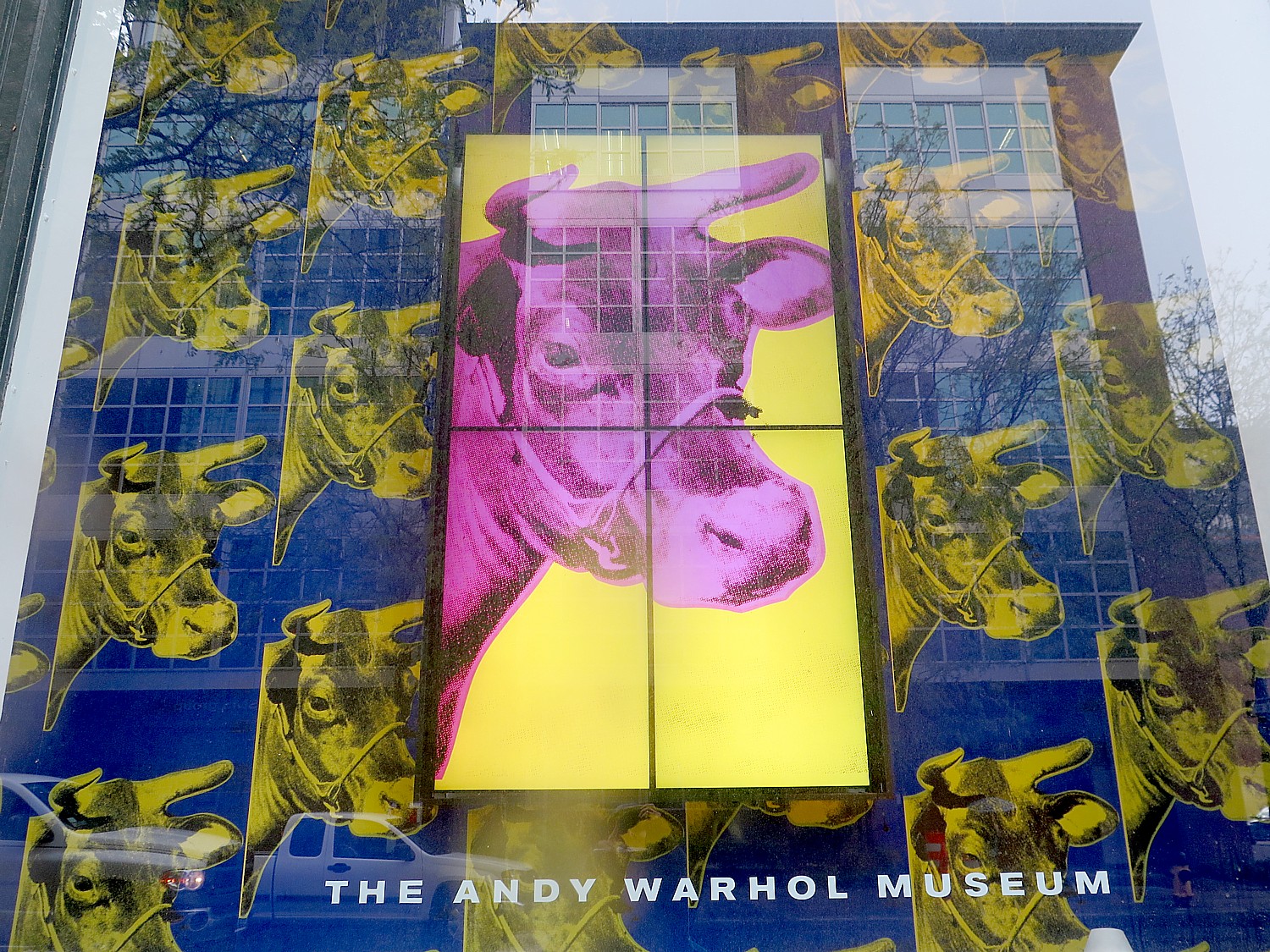The Andy Warhol Museum pays homage to a native son of Pittsburgh © 2016 Karen Rubin/goingplacesfarandnear.com
I have come to Pittsburgh for the three-day, 120-mile Rails-to-Trails Conservancy’s Spring Sojourn on the Great Allegheny Passage that starts in Cumberland, Md. and ends in Pittsburgh, and used it as an opportunity to explore Pittsburgh, a city that once was known for steel mills, but which now has won accolades as “America’s most livable city.” I am fascinated to see how it made such a transition from grey to green.
With only one full day to explore, I specifically seek out attractions that define Pittsburgh, all walkable within the downtown, getting advice from the Omni William Penn Hotel concierge.
I start at its two remaining funiculars, going up the Monongahela Incline and down the Duquesne Incline which date from the 1870s, and stroll Grandview Avenue that links the two, and continue on to Point State Park and the Fort Pitt Museum (see 7/21).
The Warhol Museum
I had not realized that Andy Warhol was a native son of Pittsburgh (born to a Slovakian family of modest means, he attended Carnegie Mellon which was Carnegie Technical at the time). The Andy Warhol Museum, one of four of the Carnegie Museums, is in the tradition of the Dali Museum in St. Petersburg, totally extolling the life of one artist. It basically continues what Andy Warhol did most successfully his whole life: market his art to inflate prices. The best part, for me, was learning more about his biography – what made him “tick”, his creative process and about his techniques.
My own belief is that Warhol was more of a marketing genius than an artistic one (at least Salvador Dali was both a marketing genius and an artistic one), who unabashedly expropriated the art, creativity and effort of photojournalists and graphic artists (indeed, many of the works produced at his factory that he signed were produced by others) but I am willing to be convinced otherwise as I roam the museum.
Indeed, as a placard notes, since the seven-story museum opened in 1994, there has been a steady increasing level of recognition of Warhol’s “singular contribution to 20th century art and his extraordinary influence on contemporary art internationally. The museum is on the forefront of research into Warhol’s work.”
There is a timeline along the massive walls that document in excruciating detail Warhol’s life and learn such tidbits as: Andrew Warhola was born in 1928 to immigrants from Mikona in Slovakia; he graduated Carnegie Tech (which became Carnegie Mellon); in 1956 he met Edmond Walloaitch who used photography in his own works; most of Warhol’s early endeavors were self-published; he was inspired by popular culture and enlarged images from magazines and photographs with a projector, then painted the projection on canvas; he used a rubber stamp, then the silk screen process; the first silkscreen painting based on a photograph was a baseball, in 1962; he “replicated the look of commercial advertising, giving Warhol faithful duplication of his appropriated source image, while also allowing him to experiment with over-painting, off-register and endless chance combinations”.
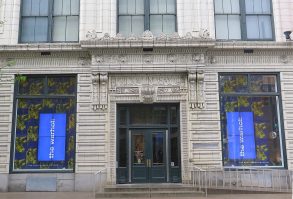
The Andy Warhol Museum, a 7-story temple to the artist which opened in 1994, was created by the Andy Warhol Foundation, Dia Center for the Arts, and the Carnegie Foundation which operates the museum © 2016 Karen Rubin/goingplacesfarandnear.com
After graduating Carnegie Tech, he took a “risk” and came to New York City where he got his big break, illustrating a story “What is Success” for Glamour Magazine. “He became one of the most successful commercial illustrators.” A particularly noteworthy item on the timeline: 1972- after publication of his “Vote McGovern,” the IRS audited Warhol annually until his death.” Warhol died in 1987, at the age of 58.
He created the “blotted line technique” – where he could trace or copy and an image “appropriating images from popular culture” – and reproduce any number of them, factory-style.
Warhol, we learn, made a fortune from portraits, once again, getting a giant commercial boost after an exhibit at the Whitney in 1979, curated by his close friend David Whitney (why am I not surprised?) consisting of 56 double portraits of artists, fashion designers, collectors, art dealers, which showcased an aspect of his painting “that he characterized as ‘business art’.”
After the 1979 show, his private portraits business hit heights- early 80s – he produced did 50 a year at $40K for 2-panel, or $2 million in annual profits.
“He was unapologetic in his imposition of lucrative business model as part of his art practice.”
I notice a prominently displayed portrait of Prince from 1984, which is up just after the musician’s death.
Andy Warhol was known for his passion as a collector – very possibly an outgrowth of his impoverished childhood and his expropriation of others’ art and design. Over his lifetime, he collected some 500,000 artifacts. There is an immense room, called the “Vault” that is filled with “time capsules” – 610 flimsy cartons, each with 500 objects.
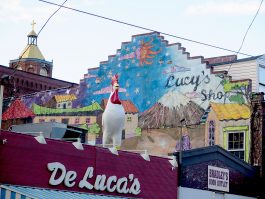
Pittsburgh’s Strip District shows off the city’s past, present and future © 2016 Karen Rubin/goingplacesfarandnear.com
I found it totally ironic, though, that you are not allowed to take any photos since Warhol’s art was based on expropriating the images and designs created by others (ie. Campbell Soup Can, Marilyn Monroe photo). You can take part in workshops to learn the silkscreening techniques he used. The museum is a must-see for anyone who is a fan.
The Andy Warhol Museum was created by the Andy Warhol Foundation, Dia Center for the Arts, and the Carnegie Foundation which operates the museum. It is one of four Carnegie Museums of Pittsburgh (Carnegie Museum of Art, Carnegie Museum of National History and Carnegie Science Center are the others, www.carnegiemuseums.org).
The Andy Warhol Museum, 117 Sandusky Street, Pittsburgh, PA 15212, 412-237-8300,www.warhol.org ($20/adults, $10/students and children 3-18, half price on Fridays, 5-10 pm; closed Mondays).
Strip District
I walk back over the 7th Street Bridge (The Andy Warhol Bridge, as it happens), into Pittsburgh’s Cultural District, where there is a cluster of theaters and galleries, including one named for another native son of Pittsburgh, playwright August Wilson (there is an August Wilson Center/African American Cultural Center, 980 Liberty Avenue, in the Cultural District).
I take it all in, but I am en route to the interestingly named Strip District, where literally in front of your eyes, you can see gentrification unfold – factories converted to apartments and lofts. This has become an amazing restaurant district, capitalizing on the diverse immigrant experience in Pittsburgh. Within a few blocks, there is a United Nations-worth of dining traditions and markets.
The Strip District is described as “authentic Pittsburgh,” where the locals go for great goods at low prices. The streets along the half-mile long district are linked with restaurants, ethnic grocers, produce stands, sidewalk vendors, meat and fish markets – a haven for foodies. It is so colorful, artful, playful.
A sign over a restaurant, Gaucho, an Argentinian Grill, which has a line of people outside waiting their turn, reads Home Improvement, Lifestyle, Dining & Entertainment. I pass Vietnamese, Korean, Thai restaurants, markets like Robert Wholey Co. purveying live Maine lobster, whole farm raised rabbits and whole duckling; a Middle Eastern grocery, Stamoolis Bros. Co, since 1909; the Pennsylvania Macaroni Company (fresh handmade mozzarella, Pennmac.com); a Mexican grocery; Pittsburgh Popcorn, next door to La Prima Espresso Corp, across the street from Chocolat; an Asian supermarket across from the Brooklyn Brewery; the S&D Polish Deli, Grandpa Joe’s Candy Shop, a textile shop selling fabrics, thread and button; and Mike Feinberg & Co’s sports store.
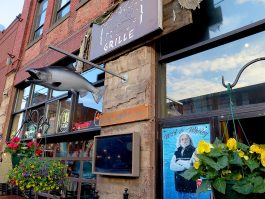
Pittsburgh’s Strip District offers trendy restaurants © 2016 Karen Rubin/goingplacesfarandnear.com
And trendy restaurants like Luke Wholey’s Wild Alaskan Grill (probably related to the market); Jade 99, Chicken Latino (Peruvian); Casa Rena (Mexican),
Walking back, I see smoke emanating from a factory with the Heinz name on it, and pass a red-brick building with a giant neon Heinz Ketchup display (above the Heinz History Center building), diagonally across from United States Steel Corporation offices (while downtown is the United Steelworkers Union building).
Senator John Heinz History Center
I am too late to visit the Senator John Heinz History Center, but it is on my list to visit when I return.
Devoted to the history and heritage of Western Pennsylvania, the 370,000 sq. ft. Senator John Heinz History Center (more formally known as the Historical Society of Western Pennsylvania) is Pennsylvania’s largest history museum and, since 2000, an affiliate of the Smithsonian Institution.
The Senator John Heinz History Center presents compelling stories from American history with a Western Pennsylvania connection in an interactive environment; the museum’s Smallman Street home combines the former Chautauqua Lake Ice Company building with a five-story Smithsonian wing.
The Western Pennsylvania Sports Museum, a museum-within-a-museum located on the History Center’s second and third floors, celebrates the region’s passion for amateur and professional sports, from football to baseball and hockey to golf.
More than 250 years of Western Pennsylvania’s history is preserved at the Thomas and Katherine Detre Library & Archives. Founded in 1879, the Library & Archives’ collections, located on the History Center’s sixth floor, are accessible to researchers, students, and the general public.
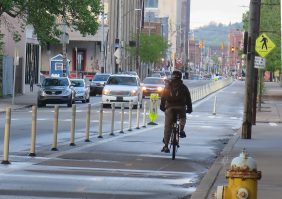
Biking on a dedicated lane in Pittsburgh © 2016 Karen Rubin/goingplacesfarandnear.com
The new Museum Conservation Center provides visitors with professional services and expert advice on how to properly preserve and care for family heirlooms.
Heinz History Center, 1212 Smallman St., Pittsburgh, PA 15222, 412-454-6000,www.heinzhistorycenter.org (10-5 daily)
Historic Omni William Pitt Hotel is at Heart of Pittsburgh
My purpose for this all-too-brief first visit to Pittsburgh is to immerse myself in the city’s proud heritage at the epicenter of the nation’s founding, settlement, industrialization and emergence as a world power, but a heritage that came at a terrible cost to its environment. The city has undertaken a fantastic revitalization, emerging from grey to green, and becoming one of America’s most liveable cities.
And so for my two-night stay, I seek out the historic Omni William Penn Hotel – a member of Historic Hotels of America – which celebrated its centennial in 2016 the same year as the city celebrated its bicentennial, and is so much a part of Pittsburgh’s story.
I love wandering around, immersing myself in the taking in the ambiance, admiring its stunning architectural features and Art Deco-style appointments, and, as if these walls could talk, hearing its stories as if whispered in my ear. There are historic displays, photos, artifacts and artwork in various places that convey the story. Indeed, in its award-winning restaurant, The Terrace Room, that dates from 1916, there is an enormous mural that pays homage to the city’s history depicting “The Taking of Fort Pitt”.
Whenever I travel, I first seek out members of Historic Hotels of America, a collection of properties. Historic hotels are so much more than mere structures. They embody the heritage and history and sense of place, and are also very much creations of their builders. Owners take on the role of steward, with a responsibility of passing it along to the next.
This is true of The William Penn, whose history parallels that of the city and the nation, as I learn from a wonderful pamphlet, “A Grand Dame Named William Penn,” by Marianne Lee.
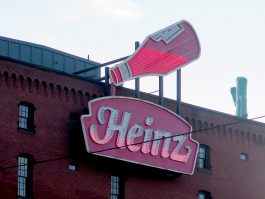
Ketchup Bottle in neon above the Heinz History Center © 2016 Karen Rubin/goingplacesfarandnear.com
The William Penn Hotel was the last building venture of Henry Clay Frick, one of Pittsburgh’s wealthiest industrialists. Frick envisioned the William Penn as Pittsburgh’s showplace, and it was designed by renowned architects Benno Janssen, and Franklin Abbott to rival the great hotels of Europe in Old World style but with what was then the state-of-the-art, sophisticated, 20th century technology. Guests were dazzled by such modern amenities including iced drinking water on top, “certified” lighting, electrically operated clocks, a telephone in every room connected to a master switchboard with 30 operators at the ready, and a private bathroom in an age when most Americans still used outdoor privies and most hotels offered only shared facilities.
Built at a cost of $6 million, when it opened, newspapers proclaimed The William Penn as the “Grandest Hotel in the nation.” Its first night featured the annual Pittsburgh Chamber of Commerce Gala, the largest gala in city history up to that time, which was hosted by US Secretary of State Philander Knox.
When the hotel was first built, it had 1,000 guestrooms (interesting to contemplate since it only has 597 today), and an elegant two-tier Grand Ballroom on the 17th floor. In 1928, the hotel was acquired by the Eppley Hotel Company and Eugene Eppley, a Horatio Alger rags-to-riches figure, financed a major expansion, the Grant Street Annex.
That added 600 more guestrooms as well as the hotel’s crowning jewel, the Urban Room, designed by Joseph Urban, when it was finished in 1929. With this addition, The William Penn became the largest hotel between Pittsburgh and Chicago, and the major convention facility for Pittsburgh.
But Eppley, who was the vanguard of a new breed of professional hotelier who saw his patrons not as customers but as guests, lost control of the hotel in the Great Depression, and new owners brought in the Statler Hotels company to manage it 1940-1951. Eppley briefly regained control, but over the years, this Grand Dame was held by Sheraton, then a group of local investors, then Alcoa, which invested $20 million in a substantial renovation, and finally Omni Hotels & Resorts, in 2001.
Throughout its storied past and many owners, The Omni William Penn Hotel has hosted many of the 20th century’s movers, shakers and celebrities. A young bandleader named Lawrence Welk, who would later gain fame for his television show, performed in the hotel’s ballrooms; the hotel’s engineers actually devised Welk’s iconic bubble machine – a connection commemorated by naming a ballroom for him, and in large photographic murals.
In 1934, a young vocalist named Dolores DeFina accepted a marriage proposal at The William Penn from the inimitable Bob Hope. The hotel remains celebrated as a wedding venue (including being named to the “Best of Weddings 2009” list by The Knot ).
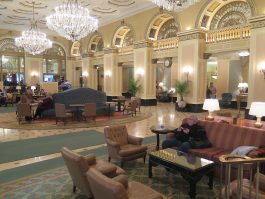
The gracious lobby of the historic Omni William Penn Hotel in downtown Pittsburgh © 2016 Karen Rubin/goingplacesfarandnear.com
A popular campaign spot as well as for presidential appearances, The Omni William Penn Hotel has received every president since Theodore Roosevelt (who visited in 1917 to attend a Moose Convention), including John Kennedy and Barack Obama.
Then, as now, The William Penn combines every modern amenity with timeless elegance: 597 beautifully appointed guestrooms including 38 suites, 52,000 square feet of flexible meeting space, and five dining venues including its fine dining room, The Terrace Room, the Palm Court, a pub-style Tap Room, Starbucks Coffee Café, The Speakeasy (in 1920s tradition tucked beneath the hotel lobby), plus 24-hour room service. The hotel boasts two self-contained conference centers, a 24-hour fitness center, beauty salon, gift shop, and a jewelry store.
There is every amenity, nicety and graciousness, beginning with fresh apples at reception and a concierge available to help with every situation. My room is outfitted with plush robe, refrigerator, bottled water, coffee maker, big screen TV, hair dryer, ironing board/iron, safe, WiFi (free if you enroll in Omni Hotels loyalty program).
I take advantage of the opportunity to order two beverages (at no charge) plus other items at modest cost for the morning ($3 for an English muffin; $3 for a toasted bagel with cream cheese, $2.75 for a muffin, $3.75 for Greek yogurt, etc.), especially when I have to leave at 5:15 am to get to the start of my Rails-to-Trails biking trip on the Great Allegheny Passage. You tell them a 15-minute window when you want it to be delivered, and sure enough, it arrives right on time. So does my car, waiting for me when I depart.
The hotel is smack in the middle of the city, walking distance to all the downtown attractions, restaurants, cultural and financial center.
Here’s a recap of my Day in Pittsburgh Walking Tour: Omni William Penn Hotel, Monongahela Incline, Duquesne Incline, Point State Park, Fort Pitt Museum, National Aviary, Andy Warhol Museum, Heinz History Center, Strip District. But one full day in Pittsburgh is simply not enough, and I can’t wait to return.
Omni William Penn Pittsburgh, 530 William Penn Place, Pittsburgh PA 15219, 412-281-7100, omnihotels.com/Pittsburgh.
For more information, contact Visit Pittsburgh, 412-281-7711, 800-359-0758, 877-LOVE PGH (568-3744), info@visitpittsburgh.com, www.visitpittsburgh.com.
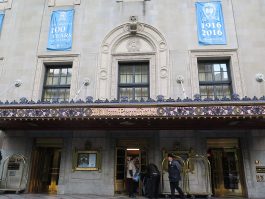
The Omni William Penn Hotel marked its centennial in 2016 the same year as Pittsburgh’s bicentennial. Located downtown, it is walking distance to many of the city’s attractions © 2016 Karen Rubin/goingplacesfarandnear.com
© 2017 Travel Features Syndicate, a division of Workstyles, Inc. All rights reserved. Visit goingplacesfarandnear.com, www.huffingtonpost.com/author/karen-rubin , and travelwritersmagazine.com/TravelFeaturesSyndicate/. Blogging at goingplacesnearandfar.wordpress.com and moralcompasstravel.info. Send comments or questions to FamTravLtr@aol.com. Tweet @TravelFeatures. ‘Like’ us at facebook.com/NewsPhotoFeatures

